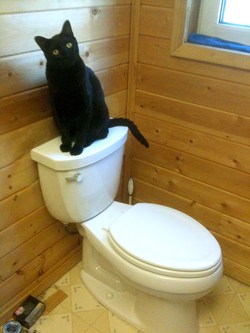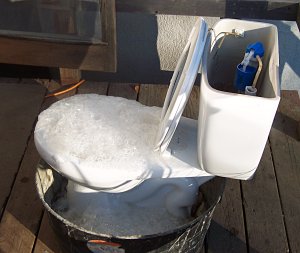A month ago, we noticed that our pump was coming on when we weren’t using any water. We immediately suspected the toilet because there was no evidence of water anywhere (on the floor, leaking under the house, etc.), but when we shut off the water supply to the toilet before going to bed, the tank was still full of water in the morning. The gaskets in our kitchen faucet were starting to fail, and it was occasionally leaking down the stem of the faucet, so we replaced the cartridge hoping this would solve our water problem. The faucet works a lot better, but we were still losing water.
We tried turning off the pump at night to confirm we really were losing water, and when we got up in the morning, we had no pressure. The combination of turning off the pump and the toilet supply resulted in no loss in pressure, so the leak was somewhere in the toilet after all. It wasn’t the flapper valve (or the tank would be empty in the morning), and we didn’t see any drips or leaks, so the supply must have been leaking into the top tank somewhere under the water and draining into the bowl where we didn’t notice it.
The obvious fix for this is to replace the stuff in the tank. But the toilet didn’t really work very well anyway, and used the full 1.6 gallons per flush. Andrea installed a dual flush kit that was supposed to use less water for liquid waste, but it didn’t work: the lower “number one” button didn’t release enough water into the bowl for it to actually flush. 1.6 gallons of water doesn’t sound like much, but we’re currently paying 10 cents a gallon for water, so we’re spending more than a dollar a day just to flush the toilet. We have an outhouse, but because we’re so close to Goldstream Creek, it can’t be in the ground and needs to be pumped out whenever it gets full. So our best option was to replace the leaking toilet with something that won’t leak, and uses less than the standard 1.6 gallons of water per flush.
The two current strategies to lowering water consumption in a toilet are to make the top tank smaller so less water is used for every flush, or to implement a dual flush setup where a small amount of water is used for liquids and the full volume flushes solids. Consumer Reports doesn’t give the dual flush models very high ratings, mostly because the bowl isn’t rinsed as well when so little water is used. As a result, we decided to get a toilet that uses a smaller top tank (1.28 gallons per flush). The highest rated model by Consumer Reports is an American Standard one-piece “Cadet 3,” but the local plumbing place and the box stores didn’t have that model in stock. Getting one shipped to Alaska would have taken more than two months. The next place models were the two-piece version of the Cadet 3 and the Kohler Cimarron. Consumer Reports gave the Cimarron slightly higher marks overall, with better bowl cleaning but worse solid waste elimination ratings. While we were in the store, we went to the web site for the company that rates toilets for solid waste elimination (www.map-testing.com) and consulted the latest ratings (from April 4th (!)). The Cimarron was better rated for this statistic (1,000 vs. 800), so that’s what we got.
Installation went smoothly. Thus far, we’re satisfied. What is surprising about the toilet is how fast it flushes. It empties the top tank into the bowl in less than a second, and the bowl empties almost immediately after that. It seems that the strategy is to dump almost all of the top tank water into the bowl as quickly as possible to eliminate waste, and use the small amount remaining to wash down the bowl. So far so good! We’re saving more than three cents each time we flush, and hopefully we will have many fewer double (and more…) flush events.
Things are slowing down as the house is ready for winter and almost everything is gone from the old place. A couple more trips this weekend and I hope we’ll be done moving. We haven’t done much unpacking, but there will be plenty of time for that now that it’s starting to get cold.
After the sunrise this morning I took Nika out on one of the trails on the other side of the road from our driveway. There’s a trail that goes along the road, and off that is a trail that goes mostly east up over the ridge, which is where I took Nika. It’s about ¾ of a mile to where the trail intersects what looks like it might be a road, but since I didn’t know where I was, I turned around and came back. You can sort of see what the environment looks like from the photo on the right. The forest was dark and the sky was lit with the sunrise, so it was hard to get a good photo.
The other photo shows the toilet repair I did earlier today. The toilet didn’t flush “all the way,” even when there wasn’t anything but liquid in the bowl. I was worried that it was installed incorrectly, but the plumber that came to charge our glycol lines said it was just scale inside the toilet. He suggested getting some hydrochloric acid and letting it dissolve the scale by running it through the toilet. But since we’ve got our own sewage treatment plant that needs to be treated gently (the instruction manual says we need to treat it like a pet, since it's a living system), I pulled the toilet out of the house and ran acid through it from the top tank into the bowl. I’m glad I did it outside, since the reaction released some really nasty smelling (and probably poisonous) gases. The photo is what happened when I neutralized the acid with a couple boxes of baking soda. The acid came with a pH testing kit to verify the acid was neutralized before disposing of the solution.
After all that, I wiped it down, installed a new wax ring, and screwed the toilet back in place. Turns out the plumber was exactly right: now it flushes like a toilet should.
I also made some time to try out a recipe from Peter Reinhart’s Whole Grain Breads. I finished reading the book last night and prepared the soaker and biga for the basic whole wheat sandwich loaf. Reinhart calls his new baking method a delayed fermentation, “epoxy” method where a large percentage of the dough is prepared in advance. Half of it is a traditional pre-ferment, with either a small amount of yeast added, or is a sourdough; and the other half is a soaker or mash that sits overnight, allowing enzymes to develop flavor and enhance the dough structure and fuel for fermentation. On baking day, you mix the two blobs of dough with the remaining flour, yeast and other ingredients, knead and bake it. Most of the gluten and flavors are developed overnight, so even though the entire process takes more than one day, it involves less effort on each day.
It’s just out of the oven now. Tomorrow, when the bread has cooled, I’ll have a report on how it turned out, but it rose nicely, and I got enough oven spring that the loaf is quite round in cross section.


